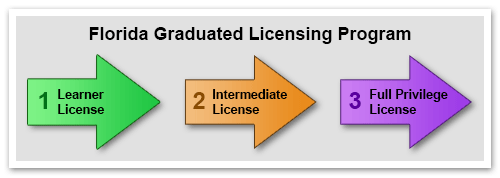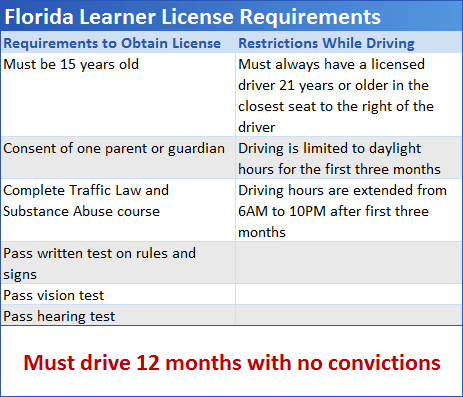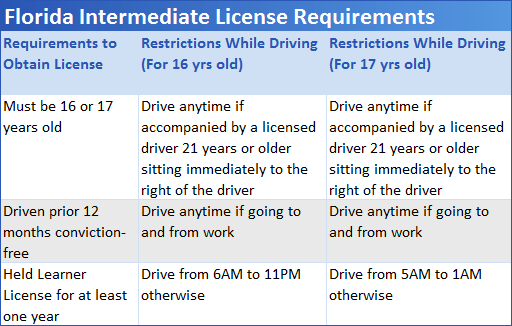Intro
The process of getting your driver's license will depend on several factors, including your age and how long you've lived in Florida.
The GDL Program
Graduated Driver Licensing (GDL) programs are designed to help young novice or new drivers adjust to the responsibility of obtaining full
driving privileges. Studies have shown that GDL programs help reduce collisions among novice drivers. Florida's GDL program applies to drivers ages 15 to 17.
The GDL program in Florida has three steps.
 Florida GDL Program
Florida GDL Program
The first step is the learner's license. In order to get your learner's license, you must be at least age 15. If you're under age 18, you'll have to have
a signed/notarized parental consent form.
Anyone who has never held a driver's license from Florida or any other state has to complete a Traffic Law and Substance Abuse Education (TLSAE) course
before they are able to apply for their driver's license in Florida. You can complete this course in a traditional classroom or online, such as
Safe2Drive's TLSAE online course. In order to get your learner's license, you'll need to show proof of completion of a TLSAE course.
Learner's license applicants must also pass a vision and hearing test. These tests are quick and completed at a service center. You'll also have
to pass the Class E knowledge exam. The Class E knowledge exam is made up of 50 multiple-choice questions about traffic laws and traffic signs. You
can take the exam in person at a service center. If you want to skip going to the service center, you can take the exam online. Safe2Drive offers
the online exam, also known as the Florida permit test. You can even bundle your TLSAE course and the permit test at a discounted price.
The final requirement when applying for your learner's license is to provide documentation to establish proof of your identity, proof of your
social security number, and proof of your residential address.
Each stage of the GDL comes with some restrictions. For the learner's license stage, leaner's permit holders must be accompanied by a licensed driver
who is at least age 21 at the time. You will need to keep your learner's license for at least 12 months or until your 18th birthday, whichever comes first.
During the first three months of holding your learner's license, you will only be allowed to drive during daylight hours. After that, you'll be able to
drive until 10 pm. While you have your learner's license, you will need to complete 50 hours of supervised driving. 10 of those hours will need to be
at nighttime.
 Florida Learner License Requirements
Florida Learner License Requirements
The second step in the GDL program is the intermediate license. You can move to this step once you are at least age 16 and have held your
learner's permit for at least 12 months without incident. During this stage, you have a bit more freedom. You will no longer have to be
supervised at all times. Those who are 16 are not able to drive between 11 pm and 6 am, unless they are driving to or from work, or accompanied
by a licensed driver at least age 21. If you're age 17, you have even more freedom, but there are still some restrictions. Those who are 17 may
not drive between 1 am and 5 am, unless they are driving to or from work, or accompanied by a licensed driver at least age 21.
 Florida Intermediate License Requirements
Florida Intermediate License Requirements
The final step in the GDL program is your full driving privleges. You must be at least age 18 to enter this stage. All restrictions are lifted
during this stage.
 Florida Full License Requirements
Florida Full License Requirements
Exams
There are several exams you may be required to complete in order to get your driver's license.
- Hearing exam. Anyone who applies for a driver's license and is deaf or cannot hear conversation spoken in a normal tone of voice will
be required to drive with an outside rearview mirror, which should be mounted on the left side of the vehicle, or they must wear a hearing aid.
- Vision exam. The vision test can be completed at any driver license service center. It involves an eye machine located on the service counter.
Those with visual acuity below 20/40 will be referred to an eye specialist before they can obtain their driver's license. If you are color blind,
do not worry! Color blindness does not affect your ability to be licensed.
- Class E Knowledge Exam. This is a 50-question multiple-choice exam about traffic laws and signs. You can complete this exam in person at a service
center or with an online test like the one offered by Safe2Drive.
- Driving Exam. If you have to take the driving exam, you will need to provide your own vehicle. It must have a valid tag and proof of insurance. Your
vehicle will also need to pass a vehicle inspection. When it's time to take the driving exam, the examiner will observe your driving skills, ensuring
that you have proper control of the vehicle and that you obey all traffic laws.
New Florida Residents
If you earned your driver's license in another state and would now like to get a Florida driver's license, you may complete an application in person
at any local office offering driver license services. Anyone applying for a new Florida driver's license must pass a vision exam, but depending on your
specific situation you may not have to complete a written or road exam.
In order to drive in Florida, new Florida residents are required to obtain their valid Florida driver's license within 30 days of establishing Florida
residency. Within 10 days of establishing Florida residency, you must have insurance from a Florida insurance agent that is licensed to sell insurance
in Florida in order to title and register your vehicle(s).
What to Bring to the Driver License Service Center
Florida requires different documentation in order to get a driver's license depending on your residency status.
US citizens who are renewing, replacing or applying for a new driver's license must submit:
- Primary Identification (e.g., US birth certificate, valid US passport or passport card, Consular Report of Birth Abroad, Certificate of Naturalization, or Certificate of Citizenship).
- Proof of Social Security. This includes an original of one of the following: Social Security Card (with your current name), W-2 form (may not be handwritten), paycheck or paystub, SSA-1099, or any 1099 (may not be handwritten).
- Proof of Residential Address. Your current driver's license or ID card does not count as proof of residential address. Instead, you must submit two different documents with your residential address. These have to be original documents, so printouts or faxes of them are not acceptable. There are many options you can use for proof of residential address, including (but not limited to): deed or mortgage, Florida voter registration card, a utility bill, medical or health card with your address listed on it, current automobile or homeowner insurance bill or policy, mail from financial institutions, and mail from federal, state, county, or city government agencies. If you do not have any of the acceptable documents in your own name, you may use two proofs of residential address from a parent, a step-parent, a legal guardian, or another person with whom you reside, and a Certification of Address form. You will not be required to present these documents again unless your name changes.
If you get married, divorced, or have a court ordered name change, you must submit the original document or a certified marriage certificate,
divorce decree, or court order. You will not be able to submit photocopies of these documents.
Sign Up for TLSAE or Permit Test